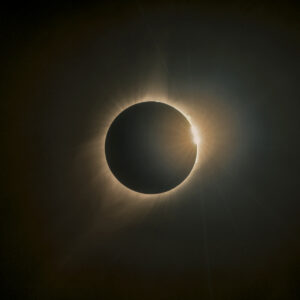Total Solar Eclipse on April 8, 2024: What to Expect
March 26, 2024
Posted by Lake Erie Nature and Science Center

The total solar eclipse on April 8, 2024 will be a once-in-a-lifetime event to experience in Northeast Ohio.
What is a solar eclipse? Well, the moon orbits Earth approximately every 27 days. A solar eclipse is the cosmic coincidence when the moon passes exactly between the Earth and the Sun, thereby casting a shadow onto Earth and blocking our view of the Sun.
On April 8, the path of totality (or the shadow of the Moon) will cross North America, passing over Mexico, the United States, and Canada. In Northeast Ohio, we will see the Moon completely cover the Sun, revealing the Sun’s outer atmosphere otherwise known as the solar corona.
You will notice the sky become quite dark and other stars and planets will be visible. Animals will behave as if it were dusk. Deer will be active, birds will head towards the trees for shelter, and nighttime insects will begin to make noise. The experience of totality will be all around you, so make sure to take it all in. Even on a cloudy day, you will still notice changes in light and temperature as the shadow of the Moon passes over us.
The Details:
Depending on your exact location in Northeast Ohio, you can plan for the following schedule on April 8:
- Partial phase begins: 1:53 p.m. – 2:01 p.m.
- Totality begins: 3:09 p.m. – 3:15 p.m.
- Partial phase begins: 3:12 p.m. – 3:19 p.m.
- Eclipse ends: 3:25 p.m. – 4:30 p.m.
Totality will last for 3 minutes and 50 seconds. The entire event will last 2 hours and 30 minutes. (Visit www.eclipseovercleveland.com/eclipseoverohio for an interactive map to find exact times and durations for your local area).
Eclipse Safety:
Eye protection is extremely important when viewing a partial or total solar eclipse. To safely observe an eclipse, you must wear eclipse glasses or number 14 welder’s glass.
Do not look at the Sun through a camera lens, telescope, binoculars, or any other optical device while wearing eclipse glasses — the concentrated solar rays will burn through the filter and cause serious eye injury.
A common myth: You do not need to wear eclipse glasses all day. Only wear them when you are looking directly at the Sun. Your pets do not need glasses either.
Eclipse Activities:
Another way to view an eclipse is to use a pinhole projector, which has a small opening (for example, a hole punched in an index card) and projects an image of the Sun onto a nearby surface. With the Sun at your back, you can then safely view the projected image. You can also take your kitchen colander outdoors and observe its shadows on the ground. The circular holes of your colander will project crescent shapes onto the ground during the partial phases of a solar eclipse.
Join Lake Erie Nature & Science Center for its planetarium show, Total Solar Eclipse, on March 30 and April 6 at 2 p.m. Recommended for ages 7 and up. Tickets: $10/person (includes pair of eclipse glasses). Advance registration is encouraged at www.lensc.org/planetarium. The Center is open daily from 9 a.m. to 4 p.m.

